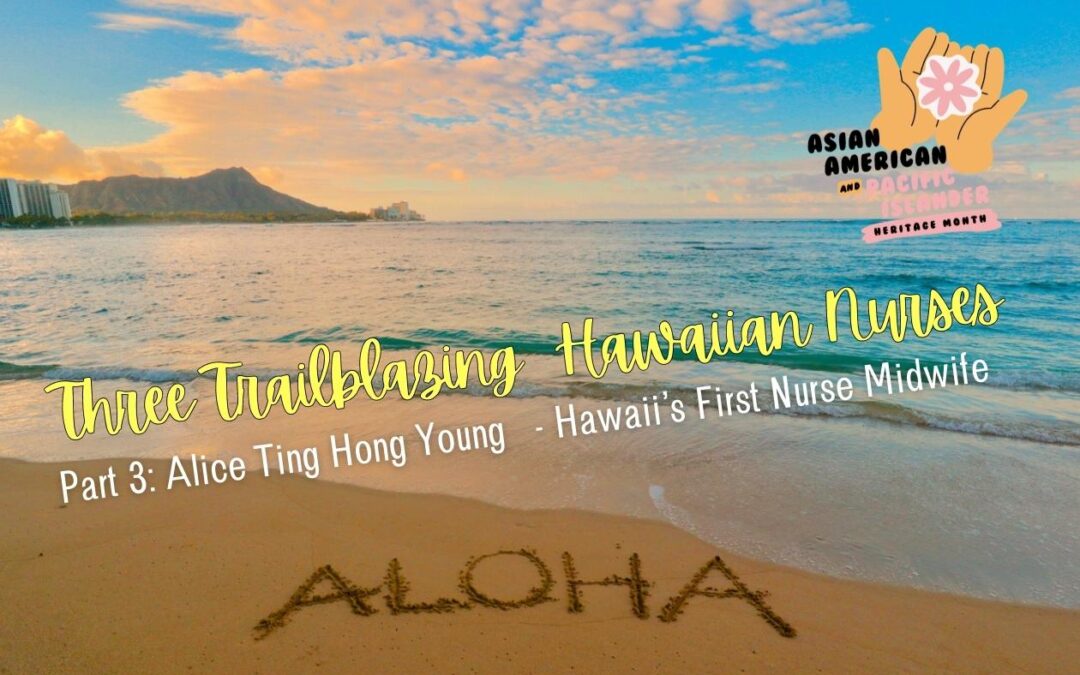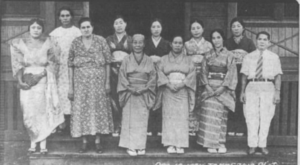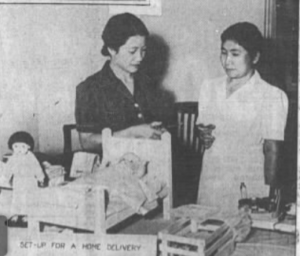Welcome to part three of Three Trailblazing Hawaiian Nurses blog series – Alice Ting Hong Young – 1911- 1992: Hawaii’s First Nurse Midwife.
In honor of Asian American and Pacific Islander Heritage Month, Minority Nurse is republishing the Three Trailblazing Hawaiian Nurses blog series from October 2022.
Hawai’i’ is one of the most multicultural and ethnically diverse places on Earth. This rich blend is reflective of its nursing history. Pioneer Registered Nurses in Hawaii include nurses of Native Hawaiian, English, Chinese, Japanese, and Filipino heritage. Their lives and work create a beautiful kaleidoscope of service that has improved the lives of residents in this tropical paradise for over 100 years. The life stories of three groundbreaking Hawaiian RNs can inspire us all.
Alice Ting Hong Young – 1911- 1992: Hawaii’s first Nurse Midwife
Alice Ting Hong Young was born on October 24, 1911, in the Chinatown section of Honolulu. Her father, Wah Kam Young, was a Chinese immigrant and fish merchant. Her mother, Bow Ngan Sum, was of Chinese and Hawaiian descent. Mr. Young died when Alice was twelve, leaving her mother with nine young children to raise.
Alice’s hopes to attend medical school were dashed due to the family’s financial hardships. Instead, after graduating from McKinley High School in 1929, at age 18, Alice entered nursing school at the St. Luke’s Hospital School of Nursing in San Francisco. There, students exchanged their labor for tuition, making it possible for poor students like Young to become RNs. In 1932, Young graduated, passed the Registered Nurse examinations, and returned home. She quickly entered the one-year public health nursing course at the University of Hawaii that Mable Smyth had co-founded six years earlier.
The Palama Settlement hired young to provide various public health nursing services upon graduation. After two years, Smyth, then the Territorial Board of Health Nursing Director, hired Young to be a public health nurse with the Territorial Board of Health on the island of Molokai. Young worked in the maternal-child, school, home health, and tubercular nursing programs.
In 1900, the population of Hawaii was 154,001. Hawaii’s four most prominent ethnic groups listed in that year’s census (in round numbers) were Japanese – 61,000, Native Hawaiians – 38,000, Caucasians – 29,000, and Chinese – 26,000. By 1930, the Territory’s population had more than doubled to 368,336, and new ethnic groups appeared in the census.
The 1930 Hawaiian Census listed 140,000 Japanese, 80,000 Caucasians, 63,000 Filipinos (none were listed in 1900), 51,000 Native Hawaiians, 27,000 Chinese, and 6,000 Koreans (also newly listed since 1900), while African Americans and Other groups combined made up fewer than 1,000 residents. This growth and change reflected the large number of Asians immigrating to Hawaii for work, primarily as plantation laborers. Among each ethnic group were educated and skilled midwives and untrained and dangerous midwives, all of whom attended home births.
In 1931 the Territorial Legislature passed Act 67, the first law to regulate the practice of midwifery in Hawaii. Midwives were required to register with the Board of Health. They were required to show proof of “being reasonably skilled and competent” in delivering babies and post-partum care, be of good moral character, and be at least 21 years old. In addition, they could only attend to women with no significant health problems and with no difficulties during their pregnancies.
Each registered midwife was issued a standard set of supplies and lengthy instructions by the Board of Health. In the first year, 168 midwives registered. Most were Japanese. Others were Filipino, Hawaiian, and Portuguese. During the 1930s, approximately a quarter of babies born in Hawaii were attended by midwives. While the law was generally successful in upgrading midwifery practice in Hawaii, there was no provision for supervision to ensure the regulations were being observed.
Young Becomes Hawaii’s First Nurse Midwife
In 1935, the U.S. Congress passed the Social Security Act, which provided funds to enhance maternal-child health services by expanding public health nurses’ skills and education. In 1936 the Hawaiian Territorial Board of Health selected Young to become the first Nurse Midwife and Midwife Supervisor for the Territory. It paid for her to go to the mainland for advanced education.
Young spent the academic year 1936-37 in New York City, earning a certificate in midwifery from a combined program sponsored by the Maternity Center Association of New York, Teacher’s College, Columbia University, and the Lobenstine Clinic in Harlem. In 1937, Young was awarded her Nurse-Midwife certificate and returned home to start her new duties.
Young visited every midwife in the Territory at least twice a year, observing and demonstrating new techniques. She inspected midwife bags to ensure all the necessary equipment was present and clean, and she followed up on reports of lay midwives practicing without a license. In addition, Young taught classes for midwives on each island. Although she spoke English, Cantonese, and Pidgin, she did not speak Japanese, so public health nurses fluent in Japanese taught the Japanese midwives. In 1940, Young wrote a manual for midwives, drawing on materials used in other states but adapting it to Hawaiian mores.
By 1940, maternal and infant mortality and morbidity rates were improving on the island, due in no small part to Young’s work. However, things changed drastically on December 7, 1941, when the Japanese attacked Pearl Harbor. Within hours, martial law was declared in the Territory; it stayed in effect until 1944. Travel was restricted, especially for Japanese residents. Because most midwives were Japanese, this forced many women to deliver babies without help or in a hospital. She told a reporter in a 1984 interview that World War II “wiped out” midwifery on the islands and that all births were mandated to occur in a hospital under martial law.
Soon after WWII began, Young met Lieutenant Commander Drew Kohler, a Caucasian from Minnesota working in naval intelligence stationed at Pearl Harbor. They fell in love and married on November 14, 1942. She continued her work with the Board of Health until she became pregnant in 1943. For several years she focused on being a new wife and mother of three small children.
Although she was no longer with the Board of Health, Kohler’s pioneering work as a nurse midwife continued. As she documented in her 1953 article in Nursing Outlook, Kohler initiated and coordinated the first childbirth education classes in Hawaii with obstetricians in private practice. In 1949, she approached a busy obstetrical office in Honolulu and was hired to create a series of six two-hour classes about pregnancy, labor and delivery, and infant care. Attendance was always high. There was a morning and afternoon class, but soon an evening class was added to include expectant fathers.
In the first 30 months of the program, 1,338 people attended the sessions. Kohler used materials from the Board of Health and the Red Cross, but, as with the Midwife Manual a decade earlier, she adapted the information to meet the cultural needs of her patients. Kohler sought donations of materials and equipment, wrote the course curriculum, and recruited public health nurses to teach the classes.
Over the following decades, Lieutenant Commander Koher’s career took the family to Japan, Taiwan, and Washington, DC. While in Taiwan, Alice Kohler worked in the obstetrics ward at the U.S. Navy Hospital.
The Kohlers retired to Hawaii in the mid-1960s. In 1984, the University of Hawaii honored Kohler with the first Distinguished Alumna Award for her commitment to nursing and the people of Hawaii. She passed away in 1992 and is buried in Honolulu.
Mabel Isabel Wilcox, Mabel Leilani Smyth, and Alice Ting Hong Young are three pioneer nurses that broke new ground in a new profession to help the people of Hawaii. They freely gave their time, energy, money, and knowledge to ensure care for the most vulnerable. Their lives and careers illuminate the best of nursing. All nurses can benefit from their examples of extraordinary service.





